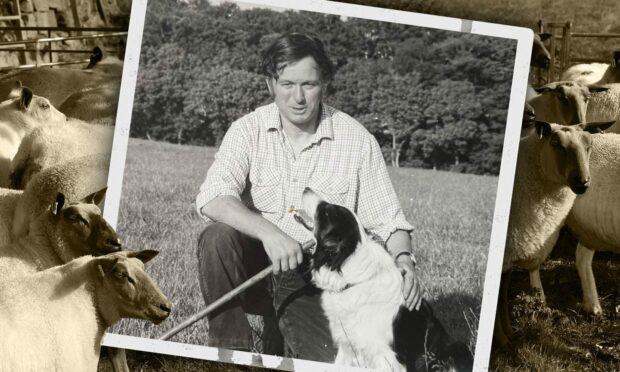Farming has a reputation of being a traditional industry, but Stewart Stevenson of Bonerbo, Anstruther, who died on September 6 after a short illness, challenged some of these traditions and helped modernise the industry.
Stewart, who was 81, made contributions to both arable and livestock farming. On the arable side, along with one or two other forward-thinking farmers and advisors, he saw the danger of farming in northern Britain being dependent on the commercial whims of international companies and pioneered the setting up of Scottish Agronomy to run extensive, farmer-led field trials of cereal varieties and fertiliser regimes.
It now provides independent husbandry advice to a large number of progressive growers in Scotland and the north of England. He also sat as a member of the National Farmers Union of Scotland cereals committee.
Livestock
He was at the forefront of livestock breeding, too. In the late 1980s he imported Bleu du Maine sheep, known for their carcass quality and prolificacy, from France, challenging the traditional breeds of this country.
There was a flurry of interest on their arrival and Stewart’s vision soon paid off. Being among the first to work with embryo transplants and synchronised lambing periods in sheep allowed Bonerbo to multiply numbers rapidly to supply the very buoyant market.
Belgian Blue cattle, with their double-muscled meaty back ends, came next. Stewart began by importing top-quality cattle then progressed to breeding them in Scotland.
Success came both in the show circuit, where he frequently won red tickets, and in the sale ring, with Bonerbo Powerhouse selling at 6000gns to Scotsire in 1999 being a
notable sale.
Meat promoter
Stewart was an early supporter of the Scottish Quality Beef and Lamb Association (SQBLA), set up to promote sales of home-produced meat, but his enthusiasm for this promotional body waned as it became increasingly linked to Government policies.
It might be thought that the man behind all these progressive initiatives came into farming laden with degrees and awards.
Not so, as he left his local secondary school, Waid Academy, as soon as he reached his 15th birthday and came home to work on the family farm.
“I never failed an exam in my life”, he would say. “Because you never sat one”, his family would reply. He then attended day-release classes at Elmwood College, Cupar, before heading to Craibstone College, Aberdeen, where he was awarded a National Diploma in Agriculture.
Awards
Stewart’s agricultural skills were both sharp and varied; he won the stock judging at the Scottish Dairy show, the tractor driving at a European Young Farmers meeting in
Belgium, and was awarded the Beef Farmer of the Year award by the Meat and Livestock Commission in 1994.
Stewart thrived on meeting people, on conversation and on debate. His time in the Young Farmers movement provided all three, beginning at his local club, East Fife. Stewart climbed the leadership tree and became club chairman in 1963/64 before continuing to become the national chairman of the Scottish Association of Young Farmers Clubs a decade later.
During his period of leadership of the then 30,000-member strong organisation, he oversaw the launch of the revised National Proficiency Test Scheme, which concentrated on improving a range of skills for those working in farming.
Scholarship
He was one of the first to be awarded a Young Farmers travel scholarship. His
year-long visit to New Zealand, seeing farming practices so markedly different to those at home, made an indelible impression on him.
Returning to the East Neuk of Fife from his circumnavigation of the globe, Stewart felt that there was nowhere he would rather live. He took over the reins at Bonerbo, developing and expanding the business over the subsequent decades, including a successful partnership with the Purvis family at neighbouring Brigton farm, starting in 1984.
In keeping with his belief in investing in training the next generation, he often employed a student. He even went as far as welcoming several to live in the farmhouse at Bonerbo, where they were tasked with feeding Stevenson toddlers at the dinner table, thus ensuring a well-rounded experience of farming family life.
Marriage and family
Stewart is survived by his wife of 49 years, Alison, the daughter of two teachers from Dundee.
They met at a Young Farmers’ dance at the Assembly Rooms in Edinburgh. Romance blossomed and they married in July 1974.
In addition to her work as a radiographer in Aberdeen, Alison was chair of Udny Young Farmers club. She later developed a successful florist business, run from Bonerbo, and Stewart’s eye for detail was often deployed putting the finishing touches to floral
arrangements.
Stewart and Alison had a family of two sons and two daughters, which expanded with the arrival of sons-in-law and daughters in-law and then 11 grandchildren on whom Stewart doted.
Motivation
Explaining his philosophy of life, Stewart would say that he had only two interests and they were, in no particular order, farming and his family. However, in an exception to this dictum, he would then recall taking part in the last Grand Match at the Lake of Menteith in 1979 where more than 2,000 curlers from all over Scotland converged for this unique competition.
Throughout his full life, he remained focused and successful and as many of his colleagues have recalled, he managed his life without division and dissent.
You can read the family’s announcement here.

Conversation